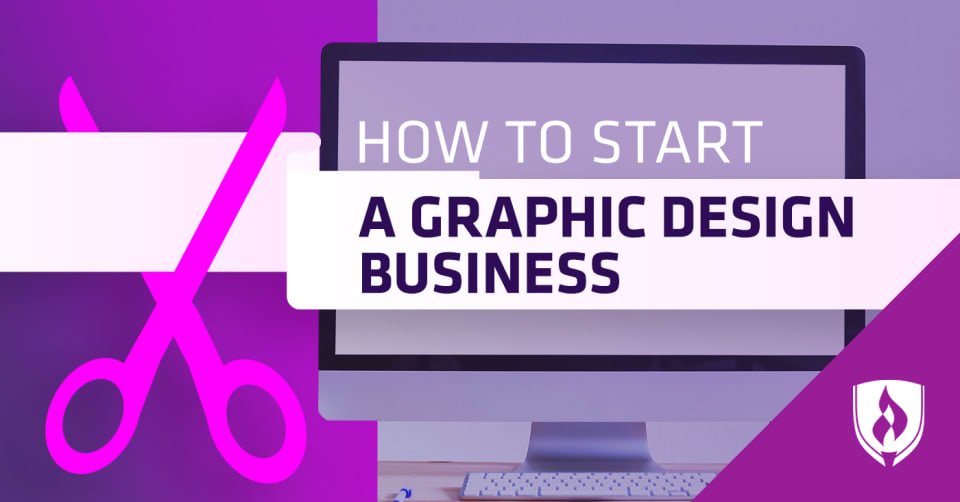How to Start a Graphic Design Business: 16 Do's and Don'ts from the Pros
By Jess Scherman on 03/27/2018

Many up-and-coming graphic designers spend years working for various agencies or taking one-off freelance projects here and there before realizing their ultimate goal is to start their own business. It can feel like those first few years of experience have properly primed you to take full ownership of your career in this way—but do you really know what it takes to build and successfully run your own small business
It has been reported that eight of every 10 entrepreneurs who start their own small businesses fail within the first 18 months. So how can you ensure that you’re one of the few small-business hopefuls who finds success as you venture into this excitingly uncharted territory?
Whether you’re ready to start your own business today or just have some long-term ambitions, it’s good to know some of the common pitfalls—and the smart moves to avoid them—when starting a graphic design business. We consulted a handful of design professionals to learn their secrets for keeping a new graphic design business afloat and building it up to eventually achieve industry success. Take a look at their must-have list of do’s and don’ts for all design hopefuls.
16 Expert do’s & don’ts for starting a graphic design business
1. DO remember your work has value
One of the most prominent lessons many seasoned designers wish they knew starting out is how to value the price of their work to avoid getting sucked into a cycle of undercharging. “Know your value and stick to it,” encourages Bonnie Bryant O’Connor, owner of Bonnie Bryant Creative. Bryant says she understands the temptation to do work at cut-rate prices as you’re starting out, but you’ll quickly learn that cheap clients can rapidly drain your time, energy and talent.
“Do not undersell yourself because you’re ‘just starting out,’ and do not take work for referrals,” agrees Jill Caren, owner of 2 Dogs Design. “Be strong and confident in your work and charge a fair rate. Bringing on clients who minimize your value will never benefit you.”
2. DON’T underestimate the power of a strong portfolio
Once you’ve built up a stable list of clientele, client reviews and referrals will go a long way in securing you additional new work. But until you reach that level in your business, your portfolio is going to have to speak for itself.
Treat your portfolio as an opportunity to not only showcase your best work, but to also clearly display the diverse range of projects you’ve worked on—versatility can be valued just as highly as inherent skills in the design industry. If you haven’t garnered enough work for a robust portfolio in your current design experience, Carlos Williams, founder of DBC, suggests doing some pro bono work for a nonprofit or other small, local organization.
3. DO craft a business plan early on
Dennis Michael, owner and visual problem solver at Wake Creative, urges anyone who’s looking to start a graphic design business to understand that doing so means you’ll become both a graphic designer and a business owner. “This means you need to balance business development and design work at the same time,” he explains. “You cannot stay behind your computer and hope people come knocking. You need to network, connect, sell and market yourself.”
O’Connor agrees. “Make sure to let people know you’re open for business and have a marketing plan in place,” she says, suggesting up-and-coming designers showcase their work through well-curated Instagram accounts, impactful e-blasts and potentially even paid advertising on social media platforms if you can swing it. “No one’s going to hire you if they don’t know who you are and what you do.”
4. DON’T expect instant success
If there’s one thing you can all but expect, it’s that business will likely seem pretty lean in the early years. “You will have months where no revenue is coming in,” Michael ensures. He encourages all new business owners to have a plan in place for these moments so you’re able to keep your head above water, and to always persist. “If you can make it into years three, five or beyond, then you have something special.”
5. DO find a mentor
Whether you feel you’re lacking in terms of design skill or business savvy, it can be helpful to connect with a more seasoned professional you respect and from whom you’d like to learn. Those who have walked a similar path before you have invaluable insight that can spare you from or prepare you for a number of challenges many face starting out.
“A mentor can be a great asset to help you understand how to properly set up your business, understand the legal side of things and bring you a sense of security when you have questions,” Caren says. She suggests contacting a local SCORE office if you need help connecting with potential mentors in your field.
6. DON’T do work just for the exposure
Whether it’s a client that wants you to do spec (free) work or it’s a project you really don’t feel passionate about, O’Connor urges young designers to resist the urge to do work just for the exposure. “If it’s a big company or organization, then they absolutely have money in their marketing budget to pay you,” she explains. It’s also true that taking on projects that don’t excite you could both dull your senses of creativity while also potentially marketing you as a type of designer you’re not.
7. DO be authentic
“Taking control of your own creative work is the best reason to start a graphic design business,” Williams says. “You get to choose the type of work you do and who you work with.” Gaining the ability to have a say in the projects you take on is one of the primary reasons designers strive to establish their own brands.
This is why it can be important to firmly establish your design aesthetic early on. Even when you’re desperate for work, remaining authentic to your personal design mission can ensure you are set on the right path to continue doing the type of work you desire to do.
8. DON’T lose sight of your “why”
One thing Ellie Anne Dote, founder and owner of EllieGirl Creations, wishes she would have grasped more firmly when she was just starting out is the importance of maintaining her ultimate reason for owning her own business. “It’s not enough to just know the industry and figure you can be successful at it,” she says. “You need to know why you do what you do and let your work be an outflowing of that.”
Dote argues that if you don’t know why you’re designing, you’re setting yourself up for the possibility of being ripped apart by the latest trends, social pressures and design opinions.
9. DO trust your instincts
All self-starters know that making mistakes is part of the game—what’s most important is that you learn from them. “Listen to your gut and be confident in your decision making,” says Danielle Becker, founder and creative director of Lefty’s Right Mind.
Becker argues that both artistry and business are largely instinctual. “When you are a full-time employee, sales, finances, health insurance and all of that other ‘fun’ stuff is taken care of for you. Running your own company leaves you completely exposed,” she explains. Stepping out of your comfort zone in this way can be intimidating, but if you trust your instincts and learn from any mistakes you make, you’ll then become more well-rounded, both as a designer and an entrepreneur.
10. DON’T say yes to every project
“When I started my business, I was so desperate to make it that I was willing to take any job that came my way, no matter how small and whether I enjoyed it or not,” Dote says. “Because I was busy chasing after so many smaller projects, I missed larger opportunities and found myself taking on projects that didn’t fit with what I had intentionally set out to do.”
While you certainly want to stay busy in the early days of owning your own business, you should still be careful to keep your eye tuned toward the future and make sure the decisions you’re making in the short-term will benefit you in the long-term as well.
11. DO find your specialty or niche
You don’t need us to tell you that graphic designers can offer a wide range of services to clients. With such a large pool of potential projects and an indisputably deep well of prospective clients, you’ll be doing yourself some huge favors if you’re able to establish your specialty and your niche target market early on.
“While many designers can do anything from designing logos to rebranding websites to retouching photos, it’s key when starting your own business to survey what you like doing most, what others have mentioned you do particularly well and whether those services are things for which the current market is willing to pay,” says Angela Martin, speaker and owner of Defining Success Coaching. Becoming known as an expert in a few key areas, she adds, will undoubtedly help bring in more business.
12. DON’T pigeonhole your client base
As helpful as it can be to find your niche early on, up-and-coming business owners should also be mindful when it comes to diversifying your clientele. “Build various revenue channels, such as business-to-business, nonprofits and agency work,” suggests Rob Satrom, owner of FeedbackWrench.
This can also mean subcontracting for some projects while sourcing your own clients for others. Satrom encourages designers to find agencies you can subcontract for—such as SEO companies, digital marketing organizations or social media teams—while simultaneously working hard to have your own clients coming in.
13. DO familiarize yourself with copywriting
If you’re really hoping to expand the power of your design work, Josh Meah, founder of Mindset Market, encourages designers to familiarize yourself with copywriting best practices. “This will give your work a degree of power, creativity and consistency that few other professionals will be able to compete with,” he says. “It will also teach you how to sell almost anything.”
14. DON’T do any work without a contract
While this one may seem obvious, its importance cannot be overstated. “Don’t do anything without a contract,” Caren urges. “We have had clients take our work and not pay us. If we did not have a contract, we would have been out of luck.”
Signed written contracts exist for both the protection of your business and your client, Martin explains. “The most important elements on that contract are the list of deliverables, key dates in the timeline and payment terms,” she says, adding that if a client increases or decreases the scope of work after a contract has been signed, you’ll want to amend the document and acquire the appropriate signatures before moving forward.
15. DO good
All creatives find themselves doing work for clients with whom they feel little connection. In fact, many view this as a challenge, tasking themselves with creating something great and transforming the project into something they can feel passionate about. But if you have time to spare, it can be worth it to donate your services to a nearby charity or local grassroots organization.
“Donate your time to a cause you are passionate about, and you will see it come back to you,” Caren says. “This is a great way to push your design limits, build up your portfolio and just be a great business owner! It will not go unnoticed.”
16. DON’T quit your day job… yet
“Design is wonderful in that you can do it from anywhere at any time,” Williams says. It can be tempting to go all-in when you first establish your budding graphic design business, but that can turn out to be a risky business move in the long-run.
“If you have a job already, start developing clients as a side hustle and do the work at nights and on weekends,” he suggests. “Sure, your personal life will take a hit. But your bank account will thank you later when you quit your job with savings and a client roster.”
Are you ready to start your graphic design business?
Use the advice of our seasoned design professionals as a metaphorical compass as you venture closer toward your goal of starting your own graphic design business. As you take the necessary steps toward making this dream a reality, you’ll want to be sure you continue polishing the skills you’ll need as a business owner.
You’ll learn quickly that the importance of a customer’s experience cannot be overstated in any industry, especially as a small business owner whose early success will rely heavily on positive referrals from satisfied clients. With that in mind, don’t let your preparations stop here. Learn more about fostering positive client interactions by visiting our article, “Your One-Stop Shop for Communicating with Design Clients.”




